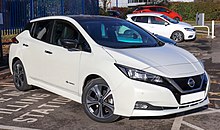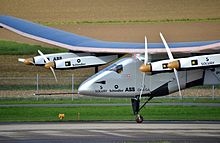Zero-emissions vehicle
This article's lead section may be too short to adequately summarize the key points. (November 2020) |


A zero-emission vehicle, or ZEV, is a
Terminology
Harmful pollutants to the health and the environment include
Examples of zero-emission vehicle with different power sources can include muscle-powered vehicles such as bicycles, electric bicycles, and gravity racers.
Motor vehicles
Also other battery electric vehicles, which may shift emissions to the location where the electricity is generated (if the electricity comes from coal or natural gas power plants—as opposed to hydro-electric, wind power, solar power or nuclear power plants);[5] and fuel cell vehicles powered by hydrogen, which may shift emissions to the location where the hydrogen is generated. It does not include hydrogen internal combustion engine vehicles because these do generate some emissions (although being near-emissionless). It also does not include vehicles running on 100% biofuel as these also emit exhaust gases, despite being carbon neutral overall.
However, these vehicles are in the early stages of their development; the manufacturing emissions may decrease by the development of technology, industry, shifting toward mass production and the ever-increasing use of renewable energy throughout the supply-chains.
History

Well-to-wheel emissions
The term zero-emissions or ZEV, as originally coined by the
However, the spread of electrical-powered vehicles can help the development of systems for charging the EV batteries from excess electricity which cannot be used otherwise. For instance, electricity demand is lowest at night and the excess generated electricity at this time can be used for recharging the EVs' batteries. It's worth mentioning that renewable sources such as wind turbines or solar panels are less controllable in terms of the amount of generated electricity compared to fossil fuel power plants; most renewable energy sources are
Fuel cell vehicles (FCVs) can help even more in terms of the development of sustainable energy sources because these cars use hydrogen as their fuel. Compressed hydrogen can be used as an energy storage element, while electricity must be stored in batteries. The hydrogen can be produced by electricity through electrolysis, and this electricity can come from green sources. Hydrogen can be produced in situ, e.g. excess at wind farm when the generated electricity is not needed, or it can be connected to the grid to use the excess electricity from the grid and produce electricity, e.g. at hydrogen pump stations. As a result, development of FCVs can be a big step toward sustainable development and reducing GHG emission in a long-term perspective.[12]
Other countries have a different definition of ZEV, noteworthy the more recent inclusion of
As a result of an investigation into false advertising regarding "zero-emissions" claims, the Advertising Standards Authority (ASA) in the UK ruled in March 2010 to ban an advertisement from Renault UK regarding its "zero-emission vehicles" because the ad breached CAP (Broadcast) TV Code rules 5.1.1, 5.1.2 (Misleading advertising) and 5.2.1 (Misleading advertising- Evidence) and 5.2.6 (Misleading advertising-Environmental claims.)[13]
Greenhouse gasses and other pollutant emissions are generated by vehicle manufacturing processes. The emissions from manufacturing are many factors larger than the emissions from tailpipes, even in gasoline engine vehicles. Most reports on ZEVs' impact to the climate do not take into account these manufacturing emissions,[6][7] though over the lifetime of the car the emissions from manufacturing are relatively small.[14]
Considering the current
Types of zero-emission vehicles
Apart from
Bicycles
This section needs expansion. You can help by adding to it. (July 2017) |
In the mid-19th century, bicycle ownership became common (during the bike boom)—predating mass car ownership. In the 1960s, the Flying Pigeon bicycle became the single most popular mechanized vehicle on the planet. Some 210 million electric bikes are on the road in China.
Motor vehicles
Marine

Lloyd's Register has partnered with a consortium of companies to develop an ammonia-fuelled ship.[21]
Air

An electric aircraft is an aircraft powered by electric motors. Electricity may be supplied by a variety of methods including batteries, ground power cables, solar cells, ultracapacitors, fuel cells and power beaming. Between 2015 and 2016,
Incentives
This section needs expansion. You can help by adding to it. (June 2008) |
Subsidies for public transport
Japanese public transport is being driven in the direction of zero emissions due to growing environmental concern. Honda has launched a conceptual bus which features exercise machines to the rear of the vehicle to generate kinetic energy used for propulsion.
Due to the stop-start nature of idling in public transport, regenerative braking may be a possibility for public transport systems of the future.
Subsidies for development of electric cars
In an attempt to curb carbon emissions as well as noise pollution in South African cities, the South African Department of Science & Technology (DST), as well as other private investments, have made US$5 million available through the Innovation Fund for the development of the Joule. The Joule is a five-seater car, planned to be released in 2014.[22] However the company ceased trading in 2012.
Low and zero emission zones
Several cities have implemented low-emission zones. Launched in 2019 and set to expand in 2023, the implementation of London's Ultra Low Emission Zone (ULEZ) incentivizes and accelerates the widespread adoption of cleaner vehicles through setting daily charge rates for driving vehicles that are non-compliant with ULEZ emission standards.[23]
See also
- List of electric cars currently available– Battery powered cars
- Coda Automotive – Former American electric vehicle manufacturer
- Electric rickshaw – Electric passenger vehicle
- GM EV1– Subcompact electric car
- Green vehicle – Environmentally friendly vehicles
- Human-electric hybrid vehicle
- Hybrid vehicle – Vehicle using two or more power sources
- Hydrogen vehicle – Vehicle that uses hydrogen fuel for motive power
- Low-carbon fuel standard – Rule to reduce carbon intensity of transportation fuels (LCFS)
- Low-emission vehicle
- Miles per gallon gasoline equivalent – Measurement of fuel economy
- Optimal Energy Joule – electric car
- Partial zero-emissions vehicle
- Personal automated transport– Public transport mode
- Super-ultra-low-emission vehicle – U.S. classification for passenger vehicle emissions (SULEV)
- Shweeb – Proposed personal rapid transit network
- Renault Z.E. – automobile model
- Tesla, Inc. – American electric vehicle and clean energy company
- Tier (emission standard)– Vehicle emission regulations
- Ultra-low-emission vehicle – vehicles that emit low levels of emissions (ULEV)
- Who Killed the Electric Car? – 2006 documentary film
- Zero-carbon city – City that has no carbon footprint
- Zero emission – engine, motor, process, or other energy source, that emits no waste products that pollutes the environment or disrupts the climate
- ZENN – Canadian electric car (Zero Emission, No Noise)
References
- ^ California Air Resources Board (2009-03-09). "Glossary of Air Pollution Terms: ZEV". Archived from the original on 2009-04-20. Retrieved 2009-04-21.
- ^ Christine & Scott Gable. "What is a ZEV - Zero Emissions Vehicle?". About.com: Hybrid Carts & Alt Fuels. Archived from the original on 2011-10-25. Retrieved 2008-04-21.
- ^ "Zero-Emission Vehicles | Caltrans". dot.ca.gov. Archived from the original on 2021-08-25. Retrieved 2021-08-25.
- US DOE. Archivedfrom the original on 2012-05-03. Retrieved 2009-04-21.
- ^ "Existing Coal Map - Beyond Coal - Sierra Club". Archived from the original on 2 June 2014. Retrieved 30 May 2015.
- ^ a b Mike Berners-Lee (23 September 2010). "Manufacturing a car creates as much carbon as driving it". the Guardian. Archived from the original on 25 April 2015. Retrieved 30 May 2015.
- ^ a b "Calculating the real carbon footprint of vehicles". Archived from the original on 31 May 2015. Retrieved 30 May 2015.
- ^ ISBN 978-0-19-537664-7.
- ISBN 978-0-8157-0305-1. Archivedfrom the original on 2019-03-28. Retrieved 2010-07-24.
- ^ Palm, Erik (2009-05-01). "Study: Electric cars not as green as you think | Green Tech - CNET News". News.cnet.com. Archived from the original on 2009-07-29. Retrieved 2010-04-18.
- ^ Lopes, JA Peças, PM Rocha Almeida, and F. J. Soares. "Using vehicle-to-grid to maximize the integration of intermittent renewable energy resources in islanded electric grids." Clean Electrical Power, 2009 International Conference on. IEEE, 2009.
- ^ Barton, John P., and David G. Infield. "Energy storage and its use with intermittent renewable energy." IEEE transactions on energy conversion 19.2 (2004): 441-448.
- ^ "ASA Adjudication on Renault UK Ltd". Archived from the original on April 5, 2010.
- ^ "Does hybrid car production waste offset hybrid benefits?". howstuffworks.com. 6 December 2010. Archived from the original on 17 May 2017. Retrieved 27 May 2017.
- ^ "Electric Car Myth Buster — Well-To-Wheel Emissions". CleanTechnica. 2018-02-19. Archived from the original on 2019-03-31. Retrieved 2019-03-31.
- ^ "Less CO2". My Electric Car. Archived from the original on 2010-05-08. Retrieved 2010-04-18.
- ^ "McKinsey Greater China" (PDF). Archived from the original (PDF) on 16 December 2011. Retrieved 30 May 2015.
- ^ PRNewswire (2013-03-28). "And Now There Is One.... Tesla Model S Declared 2013 World Green Car". International Business Times. Archived from the original on 2013-05-24. Retrieved 2013-03-28.
- ^ "MIT study: Hydrogen car no environmental panacea". EurekAlert!. 10 March 2003. Archived from the original on 30 May 2015. Retrieved 30 May 2015.
- ^ "Whitepaper "The Role of the Segway PT in Emissions Reduction"". archive-it.org. Archived from the original on 2012-08-30. Retrieved 2018-01-14.
{{cite web}}: CS1 maint: bot: original URL status unknown (link) - ^ Saraogi, Varsha (10 March 2020). "Q&A: Lloyd'ss Register on the future of ammonia-powered ships". Ship Technology. Archived from the original on 1 April 2020. Retrieved 16 April 2020.
- ^ "Environmental Topics & Sustainable Development". Archived from the original on 5 March 2016. Retrieved 30 May 2015.
- ^ Mayor of London (10 February 2023). Inner London Ultra Low Emission Zone Expansion One Year Report (PDF) (Report). pp. 10, 27. Retrieved 26 April 2023.
External links
- Rating, Smog. "DriveClean California". DriveClean. Retrieved 2017-06-08. Official California site on ZEVs and PZEVs
- Heywood, John B. (2006-08-16). "Fueling Our Transportation Future". Scientific American. 295 (3): 60–63. PMID 16925036. Retrieved 2017-06-08.
- "Caltrans Zero emissions vehicles".




